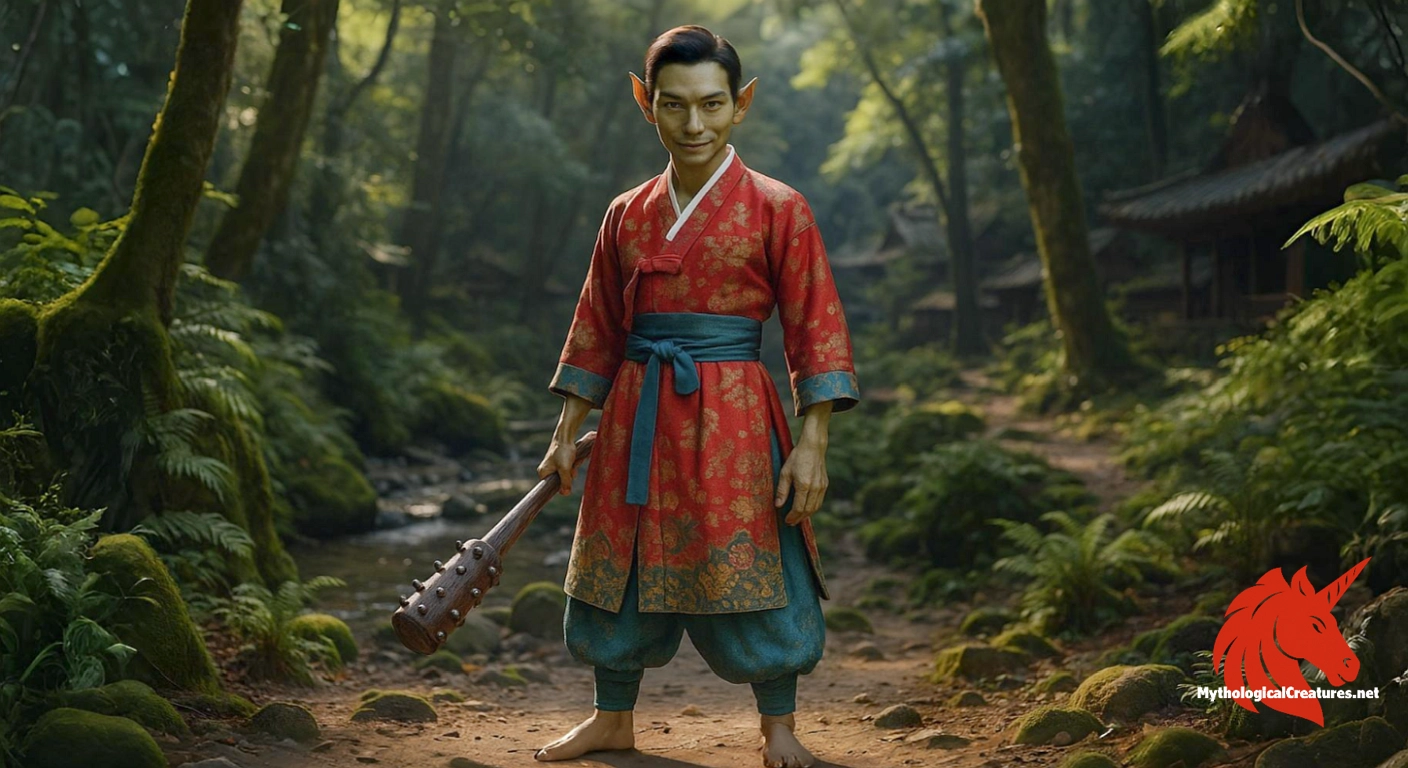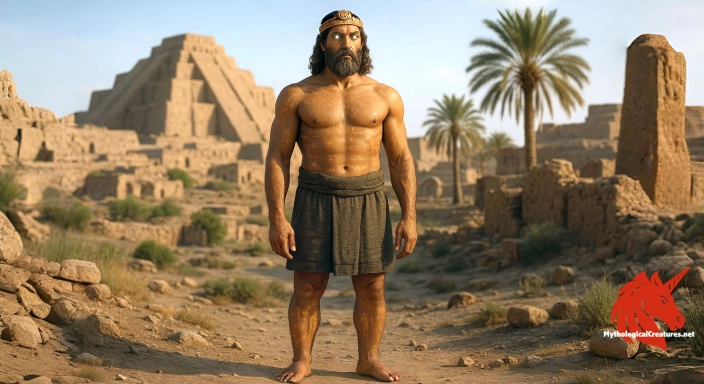Dokkaebi: Dokkaebi are legendary Korean goblins known for their mischievous yet magical nature.

Dokkaebi
Dokkaebi - Dokkaebi embody the dual qualities of benevolence and mischief, reflecting the enigmatic forces of nature in Korean folklore.
Origins & First Encounters
Dokkaebi emerge from the rich tapestry of Korean mythology as multifaceted beings, often classified as nature deities with a whimsical yet enigmatic aura. Their origins are steeped in ancient shamanistic traditions, where the interplay between humans and the supernatural was a constant theme. They first appear in folklore passed down through generations, embodying both the benevolence and trickery that characterise human interactions with the wild. Over time, these figures have been depicted as both mischievous pranksters and helpful guardians, reflecting the dual aspects of reality and myth. The cultural context surrounding dokkaebi is deeply intertwined with traditional rituals and the celebration of nature's unpredictable forces. Their presence in communal stories underscores a respect for elemental power and the capriciousness of fate. Many narratives include the detail of dokkaebi donning the hanbok, which symbolises their connection to Korean heritage. Their myth signifies a continuum of human emotion and the mysterious energies believed to inhabit the natural world.
Source Texts & Tale Variants
Ancient oral traditions and a wealth of folk tales form the backbone of dokkaebi lore, transmitting their stories long before the advent of written records. Numerous regional accounts, preserved in local legends and shamanistic chants, provide a mosaic of interpretations that vary widely in tone and detail. Storytellers have captured dokkaebi in epic narratives that blend moral lessons with supernatural intrigue, ensuring these figures remain perennial in cultural memory. Traditional literature often recounts encounters between humans and these spirited entities, illustrating both their capacity for mischief and their role as benefactors. Various compilations of Korean folklore, collected over the centuries, consistently reference these beings under a variety of guises. The narrative threads found in these sources reveal a creature whose characteristics shift between playful trickery and awe-inspiring power. Folklore anthologies have documented elaborate story variations that detail unique encounters, further cementing their place in the mythic landscape. In transforming oral tradition into textual records, the dokkaebi have been immortalised within a framework that celebrates both their mystique and mundane connections to everyday life. Their stories continue to be retold by modern enthusiasts, ensuring the legacy of ancient texts lives on in the collective imagination.
Form & Powers
The dokkaebi are depicted in a manner as fluid and unpredictable as their temperaments, often taking on forms that defy easy categorisation. While many images render them as humanoid figures, subtle hints of the supernatural prevail, with exaggerated features such as elongated limbs or unnaturally vibrant facial expressions. Traditional portrayals frequently show them adorned in the colourful hanbok, bridging the gap between the earthly and the mystical. Their eyes are sometimes described as gleaming or even otherworldly, inviting both wonder and a touch of apprehension. Numerous accounts suggest that their appearance can shift, with some versions featuring horn-like protrusions or multiple faces that emphasise their trickster nature. The variability in their depiction seems to correspond with the changing cultural and regional tastes, where each retelling bestows a new, often symbolic, dimension. Art from old temples and painted scrolls often captures a dynamic form that is both mischievous and imposing, suggesting a being whose physicality is as animate as its character. Their size, too, is subject to change; in some narratives they appear diminutive enough to be playful sprites, while in others their stature is large and commanding. This mutable physicality underlines the dokkaebi’s role as liminal beings straddling the boundaries of myth and reality.
Regional Faces
The depiction of dokkaebi subtly varies across different regions of Korea, with local folklore imbuing them with distinct characteristics that reflect regional values. In the countryside, they are often portrayed as rustic guardians of the forests and mountains, emphasising their close ties to nature. Rural tales sometimes depict them as helpful spirits, intervening in times of need or rewarding human ingenuity. In contrast, urban legends imbue dokkaebi with a more restless and enigmatic presence, often involving playful pranks amidst the bustling life of city streets. Local adaptations have led to unique narratives where these creatures are integrated into community rituals and seasonal festivities. Some regions emphasise their role as custodians of local spirits, protecting sacred groves or ancient wells. The adaptation of dokkaebi traits in various locales reflects the broader syncretism seen in Korean folklore, blending indigenous shamanistic rites with historical narratives. Even small villages have their own versions, where dokkaebi can either be mischievous troublemakers or embodiments of good fortune. This regional diversity enriches the dokkaebi myth, highlighting how a single entity can be reinterpreted to suit the cultural and geographic peculiarities of different Korean communities.
Cultural Parallels
The dokkaebi share a fascinating array of similarities with trickster and nature spirit figures found across global mythologies. Their playful yet unpredictable nature draws parallels with European goblins and the elusive leprechauns of Irish legend, where humour and mischief often serve as both a charming and cautionary motif. Comparisons can also be drawn to East Asian yokai, whose variable depictions capture a blend of mysticism, humour, and sometimes peril. These cross-cultural resemblances underscore a common human impulse to explain the inexplicable through beings that embody both order and chaos. The dokkaebi, however, retain a uniquely Korean aesthetic marked by traditional attire and specific cultural practices that ground them in the local landscape. Their narratives highlight a universal archetype that blends elements of benevolence with an undercurrent of danger, serving as both protectors and provocateurs. This intertwining of human and supernatural realms is echoed in similar mythologies that use such figures to symbolise the unpredictability of life. The universal presence of trickster deities across continents provides rich material for comparative reflection on how societies understand the interplay between the known and the mysterious. In drawing these parallels, it becomes evident that dokkaebi act as a cultural mirror, reflecting Korea’s historical nuances alongside broader mythological patterns. The study of these comparisons reinforces the idea that many cultures value the dynamic tension between discipline and unpredictability in their mythic narratives.
Legacy & Modern Evolution
The dokkaebi have evolved remarkably over the centuries, adapting to the shifts in societal values and cultural narratives within Korea. Originally emerging as purely supernatural entities in folk narratives, they have been gradually reimagined in art, literature, and modern media, becoming vibrant symbols that traverse the old and the new. In traditional settings, they embodied the capricious forces of nature and served as both warnings and guides, but today they are often celebrated as playful icons of cultural identity. Their modern depictions in films, television series, and graphic novels showcase a blend of charm and mischief that appeals to contemporary audiences. Although their historical roots lie in ancient animistic traditions, the dokkaebi have acquired new layers of meaning as metaphors for human ingenuity and the unpredictable aspects of fate. The evolution of their portrayal has allowed them to remain relevant, bridging generational gaps and resonating with both purists and new enthusiasts alike. Modern adaptations have not shied from highlighting their dual capacity for trouble and tenderness, reflecting current societal reflections on morality and nature. Their enduring presence in popular culture is a testament to the power of myth to adapt and inspire, ensuring that the dokkaebi remain an essential emblem of Korea’s rich supernatural heritage. As symbols of both caution and creative spirit, these spirits continue to inspire artistic reinterpretation and cultural celebration in a modern context.
Interesting Fact
A particularly fascinating aspect of dokkaebi is their reputed ability to transform their appearance at will, symbolizing the fluid nature of identity in Korean mythology.
Quick Creature Info
Origin:
Features:
Associations:
Our Mythic Legendary Rating:

Also Sometimes Known As:
Habitat:
Supernatural Powers:
Physical Attributes:
Abilities:
Behavior:
Lore:
Related Creatures, Tales or Lore
- GGoblins (Western Folklore)
- LLeprechauns (Irish Folklore)
- BBoggarts (British Folklore)
References
Discover Another Mythical Legend You May Not Have Heard Of?
Uncover the mysteries of ancient folklore and expand your knowledge of legendary beings from cultures around the world.
Dare to Meet the Alammuš....
Curated by the Mythological Creatures Team (rev. May 2025)
